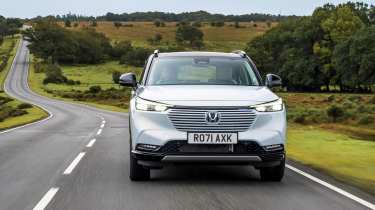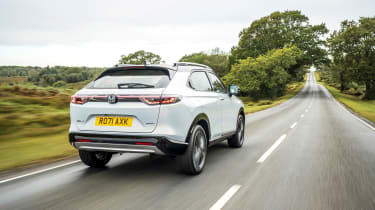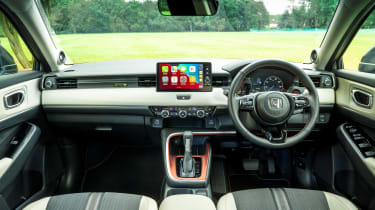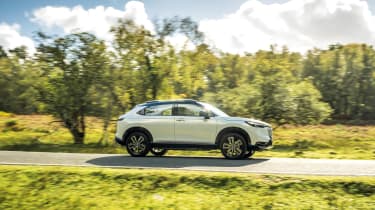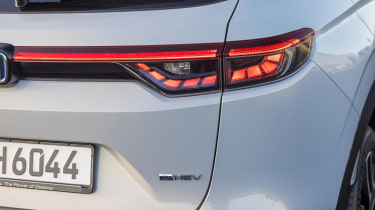Honda HR-V e:hev 2021 review – new hybrid to rival Nissan Qashqai and Toyota C-HR
Curious hybrid arrangement has gaps in its repertoire, but the HR-V is otherwise a rounded and efficient everyday driver
It’s not every day that a genuinely different powertrain layout reaches the most obsequious of motoring genres, so when Honda revealed its latest e:hev hybrid drive system, it led to some curious reading. First debuted in the Honda Jazz, it’s now available in the all-new HR-V – a crucial model for the brand, globally – giving us the chance to see how this new hybrid system works, and whether it’s any good.
First, the basics. The HR-V’s e:hev system can be a little tricky to pigeonhole into a traditional hybrid category, but essentially attempts to prioritise its electric motors without the need to plug into mains electricity. It does this by combining a small lithium-ion battery pack with two electric motors – a small one that acts as a generator, and a second, larger one that drives the front wheels. There’s then a naturally aspirated 1.5-litre four-cylinder engine (with VTEC) that runs the more efficient Atkinson cycle, just like a Toyota Prius.
It’s from here things get a little complicated, as rather than using a CVT or planetary gear set, the combustion engine is connected to the drivetrain via direct drive. In low-speed and city driving, the HR-V runs entirely on the electric motor, but when you ask for more power the petrol engine will fire up, driving more current through the electric motor than the battery alone would be able to supply. Any excess power from the petrol engine is then fed back into the battery pack, negating the need to plug in. So too will the petrol engine charge the batteries of its own accord if they need it.
Then at motorway speeds, Honda says the petrol engine will also drive the front wheels directly, operating at optimum revs depending on the performance required. At high speeds, the feel isn’t dissimilar to that of a CVT, but feels even more disconnected as the revs don’t build in a linear curve and then hold at a peak, but rather rise and fall at certain points of the rev band depending on what’s being asked of it.
More reviews
There isn’t a tachometer to tell you what the revs are doing, either. Instead, an energy use gauge shows you how much power you’re asking for without telling you how you’re getting it. This ambiguity is heightened further by the sense of isolation from the petrol engine – the unit is remarkably noise- and vibration-free until you plant the throttle, when the little four-pot will start to elicit a distant, but still annoying thrum akin to a screaming toddler being smothered in the back room of a church during service.
With 129bhp and 187lb ft of torque from the combined powertrain it’s certainly not a quick car, and the 10.6sec 0-62mph time might even feel a little ambitious, but at low speeds it seems to work well – acceleration is smooth and linear, and the engine itself is remarkably refined and, as mentioned, isolated from the cabin. Initial take-off from the electric motor is just about perky enough not to make you feel vulnerable when pulling onto main roads, but things start to go wrong on faster roads.
At motorway speed the electric motor just doesn’t have the power to maintain a steady pace without calling on help from the petrol engine, especially on inclines. This sends the petrol into action, but with an immediately high load required, it steams up to a buzzy high-rev point and stays there, even after backing off. It makes the whole powertrain feel quite stressed, and not particularly comfortable.
When back in its comfort zone, however, it’s remarkably efficient without relying on help from a plug point, making the most of every drop of fuel without breaching a point of diminishing returns like so many plug-ins do that favour on-paper figures and not real-world use. Overall, economy in a mixed selection of urban and motorway driving averaged around 48mpg, with over 50mpg achieved in town, and about 45mpg on the motorway.
As for the rest of the HR-V, it’s actually pretty good. The ride is a touch firm considering the car’s intended use, and the steering’s weighting is a little overzealous when cornering at speed, but the rack itself is accurate and easy to read. The interior design is also a huge step up over those of previous Hondas in terms of perceived quality and tech, which bodes well for future models such as the new Civic Type R, which should adopt many of the same fixtures and fittings.
The exterior design is also very well resolved. Yes, it includes pretty much every 2021 car design trend doing the rounds right now, from the two-tone paintwork and diamond-cut wheels to the rear light bar and sloping roofline, but it’s all packaged together with some sleek and restrained lines, and there’s even a subtle nod to the Ferrari Roma and its body-coloured grille.
So the good news is that despite a potentially dire combination of city-based compact crossover and a hybrid powertrain, the HR-V is not just adequate for its intended use, but actually pretty good when considered as a whole package on account of its detailing, quality, refinement and general competence. The powertrain isn’t flawed, per se, but is very much angled for urban use, which no doubt fulfills the brief for a majority of this car’s buyers. This same powertrain would more than likely be improved with an upsized electric motor, so we’ll have to see what Honda has planned next.
Prices and rivals
There are three well-specced versions of the new HR-V available, from £26,960 and topping out at £31,660. Key elements such as the responsive 9-inch touchscreen, reversing camera, climate control and LED headlights are standard-fit across the range, with higher-specification models adding sundry elements such as heated seats, a powered tailgate, two-tone paint and roof rails to the equipment list.
Key rivals include the Toyota C-HR, which shares a similar urban focus, while the slightly bigger Nissan Qashqai with its mild-hybrid powertrain is more settled on larger roads. Both Toyota and Nissan have more variability in the range, but neither ostensibly drives better than the other, which is when showroom presentation and running costs come in. When considered as such, the Honda HR-V makes a strong case, so long as you don’t venture onto motorways with any regularity.

